Risk Assessment of Ship Navigation in the Northwest Passage: Historical and Projection
Abstract
1. Introduction
2. Datasets and Methods
2.1. Datasets
2.1.1. Canadian Ice Service Digital Archive
2.1.2. ERA5 Reanalysis Data
2.1.3. Water Depth Topographic Data
2.1.4. Community Earth System Model Large Ensemble
2.2. Calculation of Sea-Ice Risk and Relating to Navigability
2.3. Classification and Calculation of Meteorological Risks
2.4. Processing of Comprehensive Risk Indicators
3. Results
3.1. Sea-Ice Risk Changes across the Northwest Passage in 1979–2019
3.2. Impacts and Trends of the Meteorological Risks
3.3. Comprehensive Risk Assessment
3.4. Projected Changes in Sea-Ice Risk and the Navigable Days
4. Discussion
Author Contributions
Funding
Data Availability Statement
Conflicts of Interest
Appendix A

References
- Comiso, J.C.; Parkinson, C.L.; Gersten, R.; Stock, L. Accelerated decline in the Arctic sea ice cover. Geophys. Res. Lett. 2008, 35, L01703. [Google Scholar] [CrossRef]
- Somanathan, S.; Flynn, P.; Szymanski, J. The northwest passage: A simulation. Transp. Res. Part A Policy Pract. 2009, 43, 127–135. [Google Scholar] [CrossRef]
- Lu, D.; Park, G.K.; Choi, K.; Oh, S. An economic analysis of container shipping through Canadian Northwest Passage. Int. J. e-Navig. Marit. Econ. 2014, 1, 60–72. [Google Scholar] [CrossRef]
- Arctic Council. Arctic Marine Shipping Assessment 2009 Report. Arctic Council, 2009; pp. 20–24. Available online: https://www.pmel.noaa.gov/arctic-zone/detect/documents/AMSA_2009_Report_2nd_print.pdf (accessed on 1 August 2019).
- Intergovernmental Panel on Climate Change. Global Warming of 1.5_C. An IPCC Special Report; Intergovernmental Panel on Climate Change: Geneva, Switzerland, 2018; Available online: https://www.ipcc.ch/sr15/ (accessed on 5 September 2021).
- Cohen, J.; Screen, J.A.; Furtado, J.C.; Barlow, M.; Whittleston, D.; Coumou, D.; Francis, J.; Dethloff, K.; Entekhabi, D.; Overland, J.; et al. Recent Arctic amplification and extreme mid-latitude weather. Nat. Geosci. 2014, 7, 627–637. [Google Scholar] [CrossRef]
- Screen, J.A.; Simmonds, I. The central role of diminishing sea ice in recent Arctic temperature amplification. Nature 2010, 464, 1334–1337. [Google Scholar] [CrossRef]
- Stroeve, J.; Holland, M.M.; Meier, W.; Scambos, T.; Serreze, M. Arctic sea ice decline: Faster than forecast. Geophys. Res. Lett. 2007, 34, L09501. [Google Scholar] [CrossRef]
- Lindsay, R.; Schweiger, A. Arctic sea ice thickness loss determined using subsurface, aircraft, and satellite observations. Cryosphere 2015, 9, 269–283. [Google Scholar] [CrossRef]
- Kwok, R. Arctic sea ice thickness, volume, and multiyear ice coverage: Losses and coupled variability (1958–2018). Environ. Res. Lett. 2018, 13, 105005. [Google Scholar] [CrossRef]
- Barnhart, K.R.; Miller, C.R.; Overeem, I.; Kay, J.E. Mapping the future expansion of Arctic open water. Nat. Clim. Chang. 2016, 6, 280–285. [Google Scholar] [CrossRef]
- Smith, L.C.; Stephenson, S.R. New Trans-Arctic shipping routes navigable by midcentury. Proc. Natl. Acad. Sci. USA 2013, 110, E1191–E1195. [Google Scholar] [CrossRef]
- Khon, V.C.; Mokhov, I.; Latif, M.; Semenov, V.; Park, W. Perspectives of Northern Sea Route and Northwest Passage in the twenty-first century. Clim. Chang. 2010, 100, 757–768. [Google Scholar] [CrossRef]
- Borgerson, S.G. Arctic meltdown-The economic and security implications of global warming. Foreign Aff. 2008, 87, 63. [Google Scholar]
- Tivy, A.; Howell, S.E.L.; Alt, B.; McCourt, S.; Chagnon, R.; Crocker, G.; Carrieres, T.; Yackel, J.J. Trends and variability in summer sea ice cover in the Canadian Arctic based on the Canadian Ice Service Digital Archive, 1960–2008 and 1968–2008. J. Geophys. Res. Ocean. 2011, 116, C03007. [Google Scholar] [CrossRef]
- Sou, T.; Flato, G. Sea ice in the Canadian Arctic Archipelago: Modeling the past (1950–2004) and the future (2041–60). J. Clim. 2009, 22, 2181–2198. [Google Scholar] [CrossRef]
- Pizzolato, L.; Howell, S.E.; Dawson, J.; Laliberté, F.; Copland, L. The influence of declining sea ice on shipping activity in the Canadian Arctic. Geophys. Res. Lett. 2016, 43, 12–146. [Google Scholar] [CrossRef]
- Dawson, J.; Pizzolato, L.; Howell, S.E.; Copland, L.; Johnston, M.E. Temporal and spatial patterns of ship traffic in the Canadian Arctic from 1990 to 2015. Arctic 2018, 71, 15–26. [Google Scholar] [CrossRef]
- Pizzolato, L.; Howell, S.E.; Derksen, C.; Dawson, J.; Copland, L. Changing sea ice conditions and marine transportation activity in Canadian Arctic waters between 1990 and 2012. Clim. Chang. 2014, 123, 161–173. [Google Scholar] [CrossRef]
- Haas, C.; Howell, S.E. Ice thickness in the Northwest Passage. Geophys. Res. Lett. 2015, 42, 7673–7680. [Google Scholar] [CrossRef]
- Howell, S.E.; Tivy, A.; Yackel, J.J.; Scharien, R.K. Application of a SeaWinds/QuikSCAT sea ice melt algorithm for assessing melt dynamics in the Canadian Arctic Archipelago. J. Geophys. Res. Ocean. 2006, 111, C07025. [Google Scholar] [CrossRef]
- Howell, S.E.; Tivy, A.; Yackel, J.J.; Else, B.G.; Duguay, C.R. Changing sea ice melt parameters in the Canadian Arctic Archipelago: Implications for the future presence of multiyear ice. J. Geophys. Res. Ocean. 2008, 113, C09030. [Google Scholar] [CrossRef]
- Howell, S.E.; Duguay, C.R.; Markus, T. Sea ice conditions and melt season duration variability within the Canadian Arctic Archipelago: 1979–2008. Geophys. Res. Lett. 2009, 36, L10502. [Google Scholar] [CrossRef]
- Howell, S.E.; Tivy, A.; Yackel, J.J.; McCourt, S. Multi-year sea-ice conditions in the western Canadian arctic archipelago region of the northwest passage: 1968–2006. Atmos. Ocean. 2008, 46, 229–242. [Google Scholar] [CrossRef]
- Kwok, R. Exchange of sea ice between the Arctic Ocean and the Canadian Arctic Archipelago. Geophys. Res. Lett. 2006, 33, L16501. [Google Scholar] [CrossRef]
- Wohlleben, T.; Howell, S.E.; Agnew, T.; Komarov, A. Sea-Ice Motion and Flux within the Prince Gustaf Adolf Sea, Queen Elizabeth Islands, Canada during 2010. Atmos. Ocean. 2013, 51, 1–17. [Google Scholar] [CrossRef]
- Howell, S.E.; Wohlleben, T.; Dabboor, M.; Derksen, C.; Komarov, A.; Pizzolato, L. Recent changes in the exchange of sea ice between the Arctic Ocean and the Canadian Arctic Archipelago. J. Geophys. Res. Ocean. 2013, 118, 3595–3607. [Google Scholar] [CrossRef]
- Fu, S.; Zhang, D.; Zhang, M.; Yan, X. Identification of environmental risk influencing factors for ship operations in arctic waters. J. Harbin Eng. Univ. 2017, 038, 1682–1688. [Google Scholar]
- Li, Z.F.; Liu, B.H.; Xu, M.Q. An Evaluation of the Arctic Route’s Navigation Environment. Adv. Mater. Res. 2012, 518, 1101–1108. [Google Scholar] [CrossRef]
- Balmat, J.F.; Lafont, F.; Maifret, R.; Pessel, N. MAritime RISk Assessment (MARISA), a fuzzy approach to define an individual ship risk factor. Ocean. Eng. 2009, 36, 1278–1286. [Google Scholar] [CrossRef]
- Ding, F.; Liu, F.; Zhang, J.; Sun, Z. Risk level grading for ship pilotage based on weather conditions. Navig. China 2019, 42, 71–74. [Google Scholar]
- Danard, M.; Munro, A.; Murty, T. Storm surge hazard in Canada. Nat. Hazards 2003, 28, 407–434. [Google Scholar] [CrossRef]
- Chauvin, C.; Lardjane, S.; Morel, G.; Clostermann, J.P.; Langard, B. Human and organisational factors in maritime accidents: Analysis of collisions at sea using the HFACS. Accid. Anal. Prev. 2013, 59, 26–37. [Google Scholar] [CrossRef] [PubMed]
- Transportation Safety Board of Canada. Statistical Summary: Marine Transportation Occurrences in 2020. 2020. Available online: https://www.bst-tsb.gc.ca/eng/stats/marine/2020/ssem-ssmo-2020.pdf (accessed on 3 January 2022).
- Koetse, M.J.; Rietveld, P. The impact of climate change and weather on transport: An overview of empirical findings. Transp. Res. Part D Transp. Environ. 2009, 14, 205–221. [Google Scholar] [CrossRef]
- Wells, P.G. The iconic Torrey Canyon oil spill of 1967-Marking its legacy. Mar. Pollut. Bull. 2017, 115, 1–2. [Google Scholar] [CrossRef] [PubMed]
- Marchenko, N.; Borch, O.J.; Markov, S.V.; Andreassen, N. Maritime activity in the high north-The range of unwanted incidents and risk patterns. POAC 2015, 15, 14–18. [Google Scholar]
- Marchenko, N.A.; Borch, O.J.; Markov, S.V.; Andreassen, N. Maritime safety in the High North–risk and preparedness. In Proceedings of the 26th International Ocean and Polar Engineering Conference, Rhodes, Greece, 26 June–2 July 2016. [Google Scholar]
- Marchenko, N.; Andreassen, N.; Borch, O.J.; Kuznetsova, S.; Ingimundarson, V.; Jakobsen, U. Arctic shipping and risks: Emergency categories and response capacities. TransNav. Int. J. Mar. Navig. Saf. Sea Transp. 2018, 12, 107–114. [Google Scholar] [CrossRef]
- Rasmussen, H.B.; Feldtmann, B. Safe navigation of cruise ships in greenlandic waters-legal frame and practical challenges. TransNav. Int. J. Mar. Navig. Saf. Sea Transp. 2020, 14, 207–212. [Google Scholar] [CrossRef]
- Zhang, Y.; Hu, H.; Dai, L. Real-time assessment and prediction on maritime risk state on the Arctic Route. Marit. Policy Manag. 2020, 47, 352–370. [Google Scholar] [CrossRef]
- Khan, B.; Khan, F.; Veitch, B. A Dynamic Bayesian Network model for ship-ice collision risk in the Arctic waters. Saf. Sci. 2020, 130, 104858. [Google Scholar] [CrossRef]
- Qian, H.; Zhang, R.; Zhang, Y.J. Dynamic risk assessment of natural environment based on Dynamic Bayesian Network for key nodes of the arctic Northwest Passage. Ocean. Eng. 2020, 203, 107205. [Google Scholar] [CrossRef]
- International Maritime Organization. International Code for Ship Operating in Polar Waters (POLAR CODE). 2015. Available online: https://wwwcdn.imo.org/localresources/en/MediaCentre/HotTopics/Documents/POLAR%20CODE%20TEXT%20AS%20ADOPTED.pdf (accessed on 13 February 2020).
- IMO. Methodology for Assessing Operational Capabilities and Limitations in Ice: Polar Operational Limit Assessment Risk Indexing System (POLARIS). 2016. Available online: https://www.nautinst.org/uploads/assets/uploaded/2f01665c-04f7-4488-802552e5b5db62d9.pdf (accessed on 5 September 2019).
- Lee, H.W.; Roh, M.I.; Kim, K.S. Ship route planning in Arctic Ocean based on POLARIS. Ocean Eng. 2021, 234, 109297. [Google Scholar]
- An, L.; Ma, L.; Wang, H.; Zhang, H.Y.; Li, Z.H. Research on navigation risk of the Arctic Northeast Passage based on POLARIS. J. Navig. 2022, 75, 455–475. [Google Scholar] [CrossRef]
- Mudryk, L.R.; Dawson, J.; Howell, S.E.; Derksen, C.; Zagon, T.A.; Brady, M. Impact of 1, 2 and 4 °C of global warming on ship navigation in the Canadian Arctic. Nat. Clim. Chang. 2021, 11, 673–679. [Google Scholar] [CrossRef]
- China Meteorological Administration. Grade of Vessel Pilotage Weather Conditions. 2016. Available online: http://www.cma.gov.cn/root7/auto13139/201702/P020191108657988301261.pdf (accessed on 11 March 2020).
- Kay, J.E.; Deser, C.; Phillips, A.; Mai, A.; Hannay, C.; Strand, G.; Arblaster, J.M.; Bates, S.C.; Danabasoglu, G.; Edwards, J.; et al. The Community Earth System Model (CESM) large ensemble project: A community resource for studying climate change in the presence of internal climate variability. Bull. Am. Meteorol. Soc. 2015, 96, 1333–1349. [Google Scholar] [CrossRef]
- Canadian Ice Service (CIS). Regional Charts: History, Accuracy, and Caveats; CIS Archive Documentation Series 1; Canadian Ice Service (CIS): Gatineau, QC, Canada, 2007. Available online: http://ice.ec.gc.ca/IA_DOC/cisads_no_001_e.pdf (accessed on 11 September 2019).
- Agnew, T.; Howell, S. The use of operational ice charts for evaluating passive microwave ice concentration data. Atmos. Ocean. 2003, 41, 317–331. [Google Scholar] [CrossRef]
- Canadian Ice Service (CIS). Regional Charts: Canadian Ice Service Ice Regime Regions (CISIRR) and Sub-Regions with Associated Data Quality Indices; CIS Archive Documentation Series 3; Canadian Ice Service (CIS): Gatineau, QC, Canada, 2007. Available online: http://ice.ec.gc.ca/IA_DOC/cisads_no_003_e.pdf (accessed on 11 September 2019).
- Hennermann, K.; Berrisford, P. ERA5 Data Documentation. Copernicus Knowledge Base, 2017. Available online: https://confluence.ecmwf.int/display/CKB/ERA5%3A+data+documentation (accessed on 1 March 2021).
- Hersbach, H.; Bell, B.; Berrisford, P.; Hirahara, S.; Horányi, A.; Muñoz-Sabater, J.; Nicolas, J.; Peubey, C.; Radu, R.; Schepers, D.; et al. The ERA5 global reanalysis. Q. J. R. Meteorol. Soc. 2020, 146, 1999–2049. [Google Scholar] [CrossRef]
- Amante, C.; Eakins, B.W. ETOPO1 Arc-Minute Global Relief Model: Procedures, Data Sources and Analysis. 2009. Available online: https://repository.library.noaa.gov/view/noaa/1163/noaa_1163_DS1.pdf (accessed on 6 January 2020).
- Hurrell, J.W.; Holland, M.M.; Gent, P.R.; Ghan, S.; Kay, J.E.; Kushner, P.J.; Lamarque, J.-F.; Large, W.G.; Lawrence, D.; Lindsay, K.; et al. The community earth system model: A framework for collaborative research. Bull. Am. Meteorol. Soc. 2013, 94, 1339–1360. [Google Scholar] [CrossRef]
- England, M.; Alexandra, J.; Lorenzo, P. Nonuniform contribution of internal variability to recent Arctic sea ice loss. J. Clim. 2019, 32, 4039–4053. [Google Scholar] [CrossRef]
- Jahn, A.; Kay, J.E.; Holland, M.M.; Hall, D.M. How predictable is the timing of a summer ice-free Arctic? Geophys. Res. Lett. 2016, 43, 9113–9120. [Google Scholar] [CrossRef]
- Zhe, W.; Ren, Z.; Shanshan, G. Natural environment risk division of the Arctic northeast channel—Taking the Northern Sea Area of Russia as an example. Ocean. Eng. 2017, 35, 61–70. (In Chinese) [Google Scholar]
- Shi, P. Theory and practice of disaster study. J. Nat. Disasters 1996, 4, 6–17. [Google Scholar]
- Neiburger, M. Visibility and Liquid Content in Cloud. J. Atmos. Sci. 1953, 10, 401. [Google Scholar] [CrossRef]
- Pinnick, R.G.; Hoihjelle, D.L.; Fernandez, G.; Stenmark, E.B.; Lindberg, J.D.; Hoidale, G.B.; Jennings, S.G. Vertical structure in atmospheric fog and haze and its effects on visible and infrared extinction. J. Atmos. Sci. 1978, 35, 2020–2032. [Google Scholar] [CrossRef][Green Version]
- Kunkel, B.A. Parameterization of droplet terminal velocity and extinction coefficient in fog models. J. Clim. Appl. Meteorol. 1984, 23, 34–41. [Google Scholar] [CrossRef]
- Eldridge, R.G. The relationship between visibility and liquid water content in fog. J. Atmos. Sci. 1971, 28, 1183–1186. [Google Scholar] [CrossRef][Green Version]
- Stoelinga, M.T.; Warner, T.T. Nonhydrostatic, mesobeta-scale model simulations of cloud ceiling and visibility for an East Coast winter precipitation event. J. Appl. Meteorol. 1999, 38, 385–404. [Google Scholar] [CrossRef]
- Fu, G.; Li, X.; Wei, N. Review on the atmospheric visibility research. Period. Ocean. Univ. China 2009, 39, 855–862. [Google Scholar]
- Stroeve, J.; Barrett, A.; Serreze, M.; Schweiger, A. Using records from submarine, aircraft and satellites to evaluate climate model simulations of Arctic sea ice thickness. Cryosphere 2014, 8, 1839–1854. [Google Scholar] [CrossRef]
- Howell, S.E.L.; Laliberté, F.; Kwok, R.; Derksen, C.; King, J. Landfast ice thickness in the Canadian Arctic Archipelago from observations and models. Cryosphere 2016, 10, 1463–1475. [Google Scholar] [CrossRef]
- Laliberté, F.; Howell, S.E.L.; Kushner, P.J. Regional variability of a projected sea ice-free Arctic during the summer months. Geophys. Res. Lett. 2016, 43, 256–263. [Google Scholar] [CrossRef]
- Peters, G.; Andrew, R.; Boden, T.; Canadell, J.G.; Ciais, P.; Le Quéré, C.; Marland, G.; Raupach, M.R.; Wilson, C. The challenge to keep global warming below 2 C. Nat. Clim. Chang. 2013, 3, 4–6. [Google Scholar] [CrossRef]
- Drewniak, M.; Dalaklis, D.; Christodoulou, A.; Sheehan, R. Ice-Breaking Fleets of the United States and Canada: Assessing the Current State of Affairs and Future Plans. Sustainability 2021, 13, 703. [Google Scholar] [CrossRef]
- Hanesiak, M.J.; Wang, X.L. Adverse-weather trends in the Canadian Arctic. J. Clim. 2005, 18, 3140–3156. [Google Scholar] [CrossRef]
- Peterson, I.; Hamilton, J.; Prinsenberg, S.; Pettipas, R. Wind-forcing of volume transport through Lancaster Sound. J. Geophys. Res. Ocean. 2012, 117, C11. [Google Scholar] [CrossRef]
- Melling, H. Sea ice of the northern Canadian Arctic Archipelago. J. Geophys. Res. Ocean. 2002, 107, 2-1–2-21. [Google Scholar] [CrossRef]
- Howell, S.E.L.; Wohlleben, T.; Komarov, A.; Pizzolato, L.; Derksen, C. Recent extreme light sea ice years in the Canadian Arctic Archipelago: 2011 and 2012 eclipse 1998 and 2007. Cryosphere 2013, 7, 1753–1768. [Google Scholar] [CrossRef]
- Qian, H.; Zhang, R. Future changes in wind energy resource over the Northwest Passage based on the CMIP6 climate projections. Int. J. Energy Res. 2021, 45, 920–937. [Google Scholar] [CrossRef]
- Stevenson, T.C.; Davies, J.; Huntington, H.P.; Sheard, W. An examination of trans-Arctic vessel routing in the Central Arctic Ocean. Mar. Policy 2019, 100, 83–89. [Google Scholar] [CrossRef]
- Bennett, M.M.; Stephenson, S.R.; Yang, K.; Bravo, M.T.; De Jonghe, B. The opening of the Transpolar Sea Route: Logistical, geopolitical, environmental, and socioeconomic impacts. Mar. Policy 2020, 121, 104178. [Google Scholar] [CrossRef]
- United Nations Oceans and Law of the Sea (UNCLOS). Commission on the Limits of the Continental Shelf. 2013. Available online: http://www.un.org/depts/los/clcs_new/clcs_home.htm (accessed on 28 October 2021).
- Lam, S.S.; Foong, S.Y.; Lee, B.H.; Low, F.; Alstrup, A.K.; Ok, Y.S.; Peng, W.; Sonne, C. Set sustainable goals for the Arctic gateway coordinated international governance is required to resist yet another tipping point. Sci. Total Environ. 2021, 776, 146003. [Google Scholar] [CrossRef]
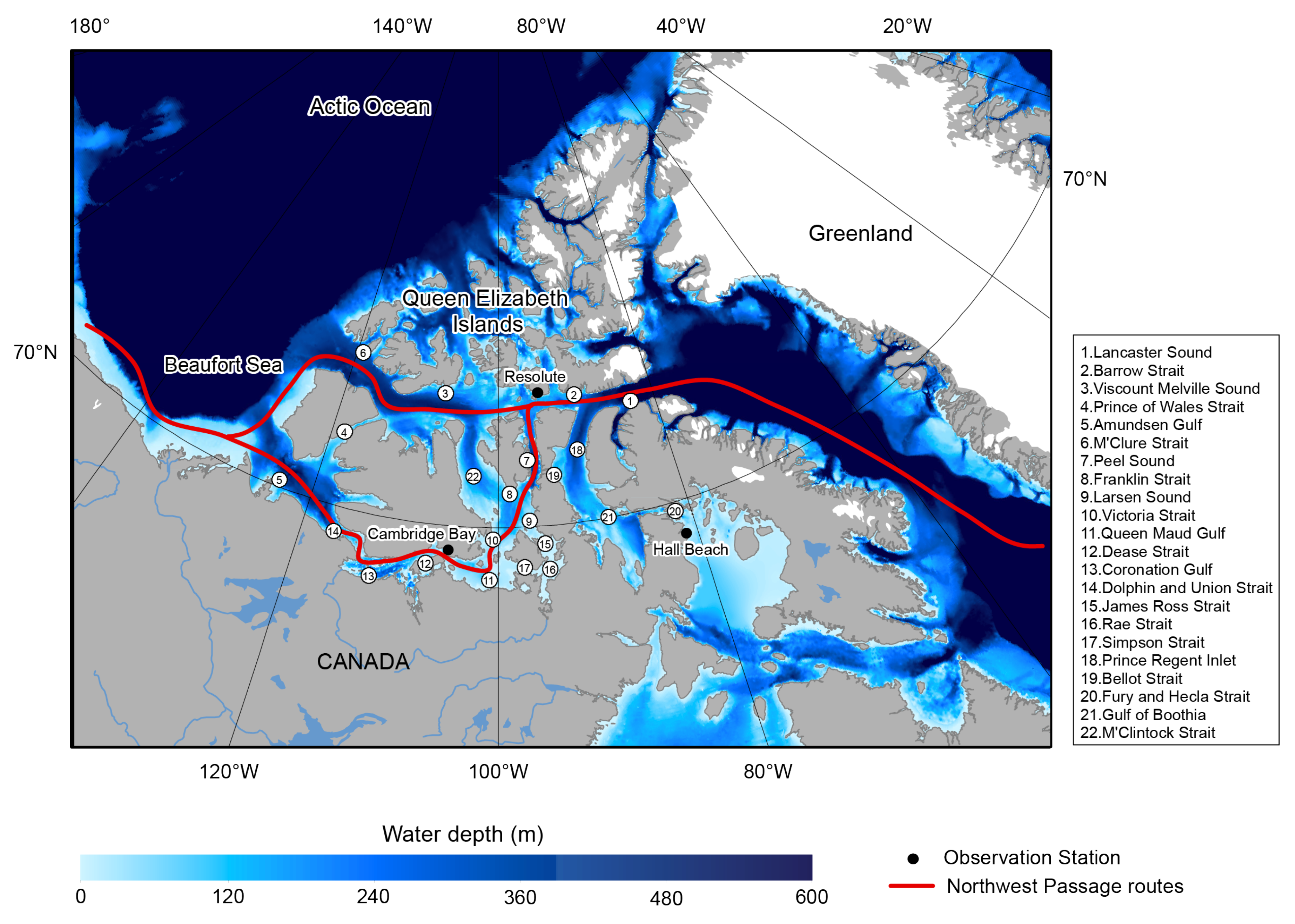

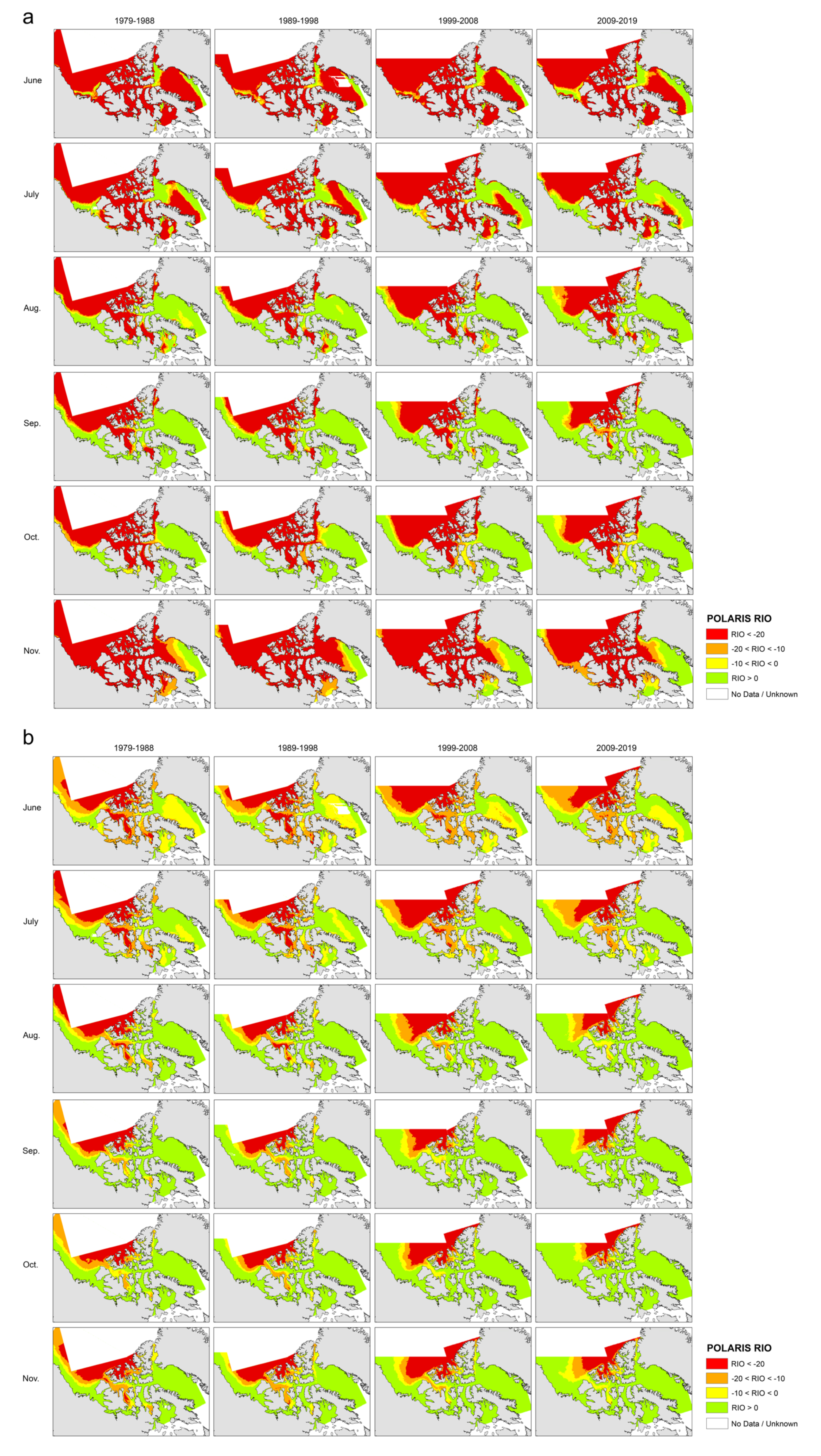


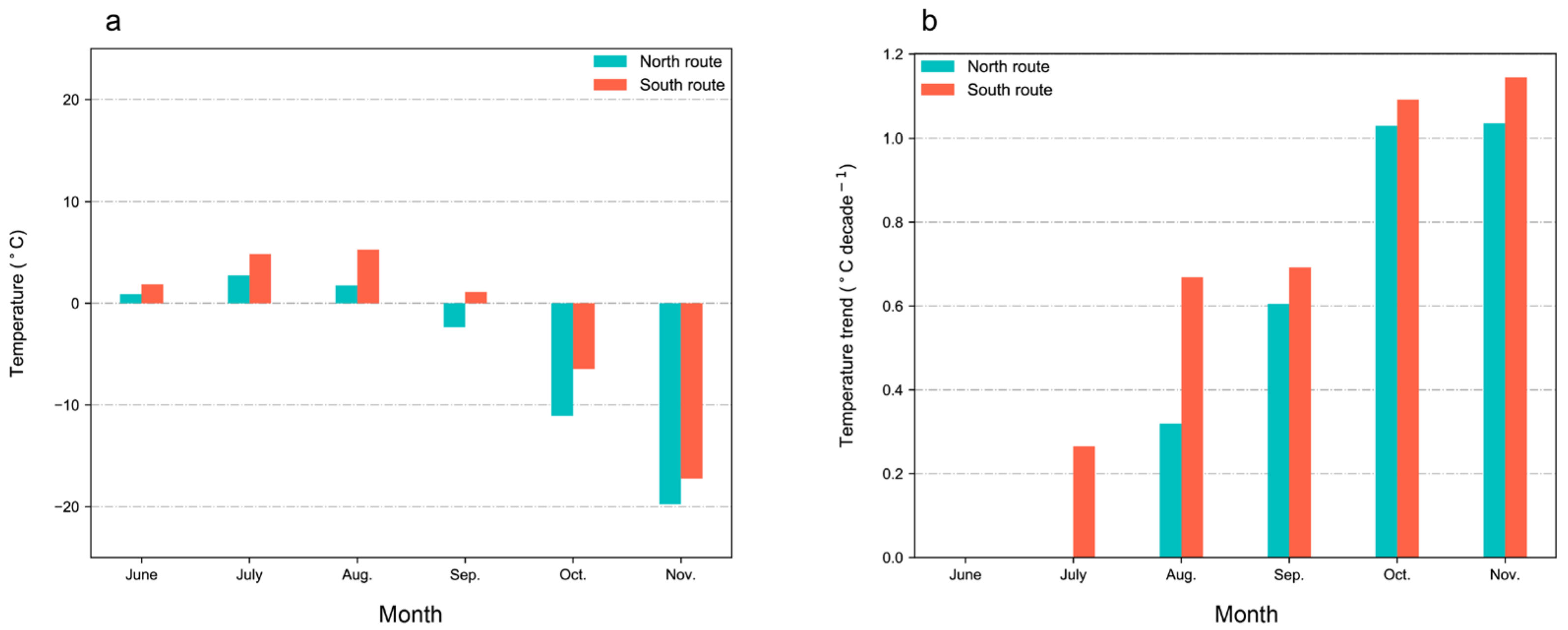
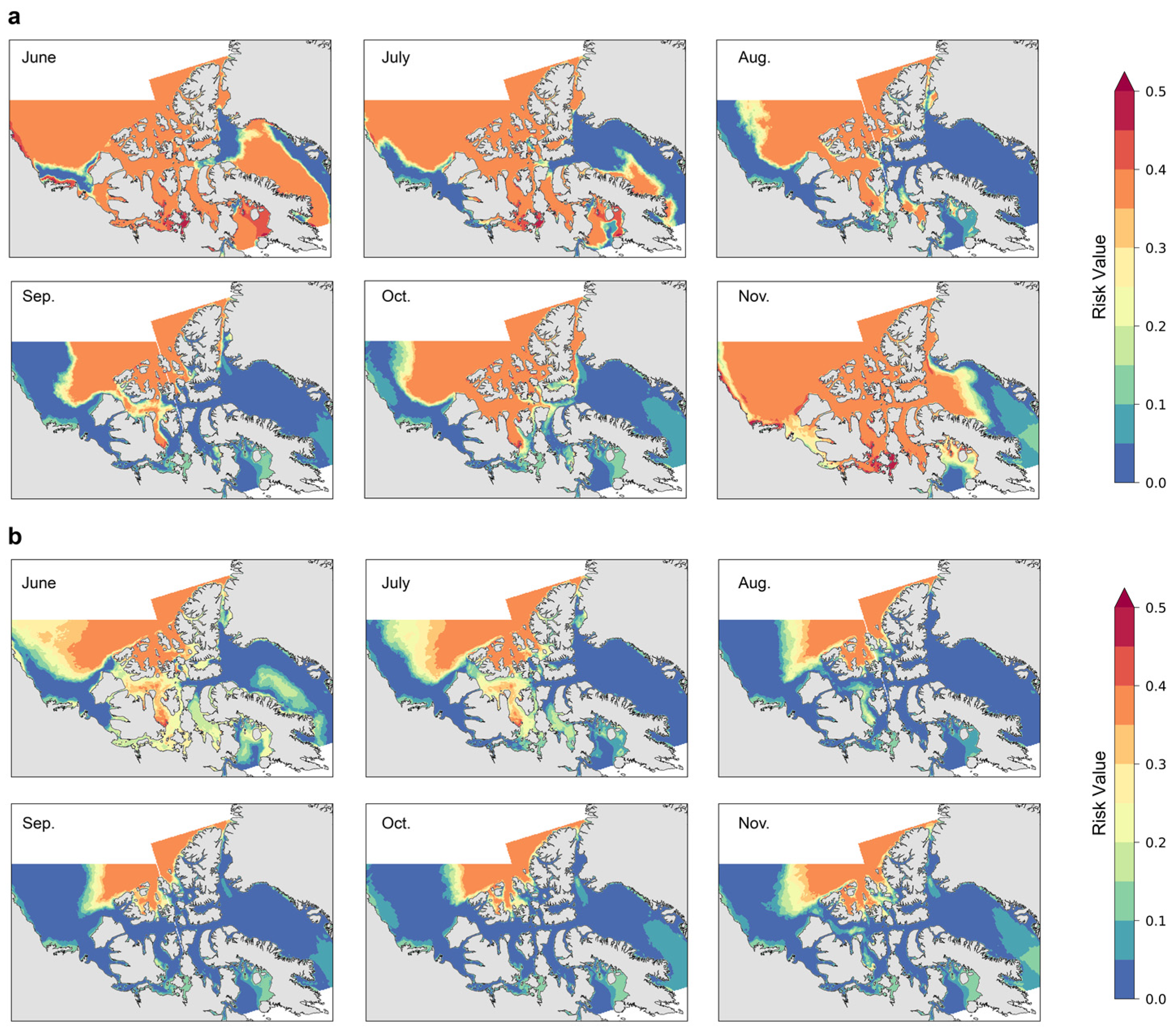
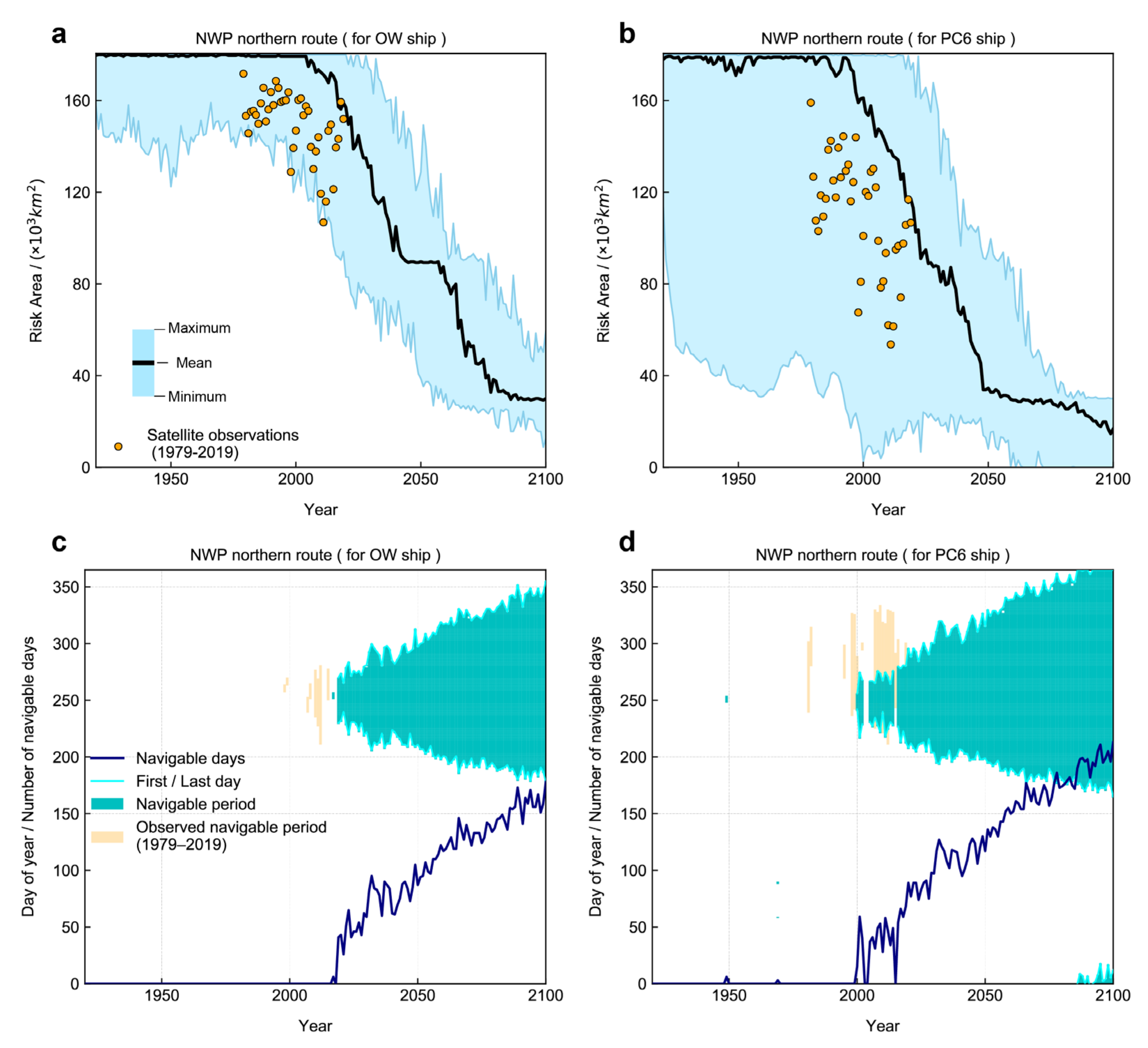
| Grades | Wind Speed (m/s) | Visibility (km) | Temperature (°C) | Risk Value |
|---|---|---|---|---|
| I | < 10.8 | 4.0 | 0 | 0 |
| II | < 13.9 | < 4.0 | < 0 | 0.25 |
| III | < 17.2 | < 2.0 | < −10 | 0.50 |
| IV | < 20.8 | < 1.0 | < −15 | 0.75 |
| V | 20.8 | V < 0.5 | V < −20 | 1 |
| Indicators | Sea Ice | Water Depth | Wind | Visibility | Temperature |
|---|---|---|---|---|---|
| Weights | 0.35 | 0.12 | 0.1 | 0.23 | 0.2 |
Publisher’s Note: MDPI stays neutral with regard to jurisdictional claims in published maps and institutional affiliations. |
© 2022 by the authors. Licensee MDPI, Basel, Switzerland. This article is an open access article distributed under the terms and conditions of the Creative Commons Attribution (CC BY) license (https://creativecommons.org/licenses/by/4.0/).
Share and Cite
Wang, C.; Ding, M.; Yang, Y.; Wei, T.; Dou, T. Risk Assessment of Ship Navigation in the Northwest Passage: Historical and Projection. Sustainability 2022, 14, 5591. https://doi.org/10.3390/su14095591
Wang C, Ding M, Yang Y, Wei T, Dou T. Risk Assessment of Ship Navigation in the Northwest Passage: Historical and Projection. Sustainability. 2022; 14(9):5591. https://doi.org/10.3390/su14095591
Chicago/Turabian StyleWang, Chuya, Minghu Ding, Yuande Yang, Ting Wei, and Tingfeng Dou. 2022. "Risk Assessment of Ship Navigation in the Northwest Passage: Historical and Projection" Sustainability 14, no. 9: 5591. https://doi.org/10.3390/su14095591
APA StyleWang, C., Ding, M., Yang, Y., Wei, T., & Dou, T. (2022). Risk Assessment of Ship Navigation in the Northwest Passage: Historical and Projection. Sustainability, 14(9), 5591. https://doi.org/10.3390/su14095591






